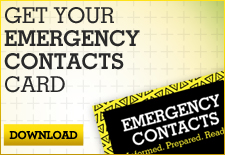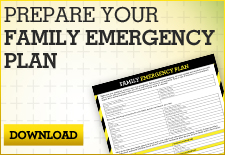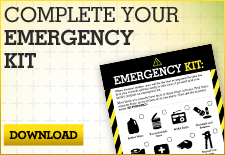
Disasters can happen… at any time. Be prepared to take action before, during and after.
Tornadoes, nature’s most violent storms, can appear suddenly and without warning — even remaining invisible until dust and debris are picked up or a funnel cloud appears. These violent storms can pack winds of up to 300 mph and leave damage trails up to 1 mile wide and 50 miles long.
In our region, Illinois ranks fifth in the nation for the most tornadoes per 10,000 square miles, the majority of the tornadoes occurred between April 1 and June 30 and between the hours of 3p.m. and 10 p.m. However, tornadoes have occurred every month of the year at all hours of the day. Nearly 30% of all tornadoes occur after dark. But it’s not just Illinois that is at risk of tornadoes, Indiana ranks 15th in the nation. Lastly, in 2011 Wisconsin experienced a tornado outbreak which was the largest April event on record as well as one of the largest single‐day events during the course of any year, 16 tornadoes touched down!
- A dark, often greenish sky
- A wall cloud, particularly if it is rotating
- Large hail, which is often produced by the same storms that produce tornadoes
- A loud roar, similar to the sound of a freight train
- Tornadoes may occur and be visible near the trailing edge of a thunderstorm
- Tornadoes may also be embedded in rain and not visible
- Stay tuned to local radio and TV stations or the National Oceanographic and Atmospheric Administration (NOAA) Weather Radio for further weather information.
- Watch the weather and be prepared to take shelter immediately if conditions worsen.
During a tornado warning:
- A tornado warning is issued when a tornado funnel is sighted or indicated by weather radar. You should take shelter immediately.
- With tornadoes, planning and practicing specifically how and where you take shelter is a matter of survival. Know the difference between a Tornado Watch and a Tornado Warning:
Before
You can find detailed information on your local TV and radio, the National Weather Service, your local government’s emergency management website and social like NOAA’s twitter and NOAA’s Facebook.
2 – Complete the Emergency Contacts Card and place one in your Emergency Kit.
3 – Prepare an Emergency Kit. The Emergency Kit should be easily accessible should you and your family be forced to shelter in place (stay at home) for a period of time.
- Listen to NOAA Weather Radio or other broadcast news for the latest information
- Look for approaching storms on the horizon
- Be aware of the danger signs:
– Dark, often greenish sky
– Large hail
– A large, dark rotating cloud (funnel‐shaped)
– Loud roar, similar to a freight train
– Locate the safest place to take shelter - Determine a place where you will take shelter in case of a tornado warning. Storm cellars or basements provide the best protection.
During a tornado, remember what is in your family emergency plan if you are at home. If you are at the office, school, or in a store, follow the instructions given to you that will help keep you safe.
- If underground shelter is not available, go into an interior room or hallway on the lowest floor possible.
- Stay away from windows, doors and outside walls. Go to the center of the room. Stay away from corners because they attract debris.
- If you’re not in your home, seek shelter in the basement or an interior room of a nearby, sturdy building. Do not try to outrun a tornado in your car; instead, leave it immediately.
- Schools should have a designated shelter area (usually an interior hallway on the lowest floor). Stay out of auditoriums, gymnasiums and other structures with wide, free span roofs.
- Get out right away and go to the lowest floor of a nearby building or storm shelter.
- Do not stay in a mobile home. They offer little protection, even if they are tied down.
- Never try to outrun a tornado in urban or congested areas. Leave the vehicle and seek shelter right away.
- Lie flat in a nearby ditch or depression. Know if your location could flood quickly.
- Do not go under an overpass or bridge. You are safer in a low, flat location.
- Watch out for flying debris. This is how most fatalities and injuries occur.
After a tornado, reunite with your family members at your pre‐designated meeting location. Remember to be extremely careful of where you walk – broken glass, nails, and power lines can all cause injury after a tornado.
- Continue listening to local radio or television stations and your NOAA Weather Radio for updated information.
- Review your Family Emergency Plan and contact your emergency points of contact.
– If all of your family members are not present, report to your family’s pre‐designated meeting point, unless emergency officials direct otherwise. - Assess any damage to your home or immediate surroundings.
– Be aware of any potential hazards such as ruptured gas lines, structural damage to your home, downed electrical lines, and localized flooding. Immediately report any injuries or hazards via 9‐1‐1. Advise your family and neighbors as well. - Call 9‐1‐1 to report injured or trapped persons.
– Give first aid where appropriate, but do not move seriously injured persons unless they are in immediate danger. Never enter any building that appears to have suffered structural damage or that poses any other hazards. - Do not enter any disaster area.
– Your presence there will simply add to the confusion and may hamper emergency response efforts. A public message will be broadcast in the event that volunteers are needed. - Use the telephone only for emergency calls.
– Once you have notified your pre‐identified emergency contact person that you are okay, let him or her notify other family or loved ones. Telephones are frequently overwhelmed in a disaster situation and need to be clear for emergency calls to get through.



